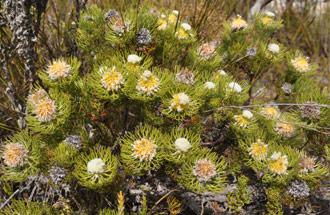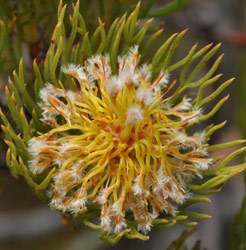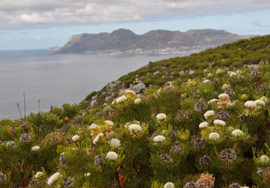Serruria villosa
Serruria villosa (Lam.) R.Br.
Family: Proteaceae
Common names: golden spiderhead, valley spiderhead (Eng.); gouespinnekopbos (Afr.)
Introduction
Serruria villosa is a charming sweetly scented shrublet suited to the wild fynbos garden.

Description
Description
Serruria villosa is an erect shrublet growing 0.3-0.5 m tall and spreading to 0.3 m. It has a neat, multi-stemmed habit, and forms a dense little bush. Leaves are needle-like with very fine hairs and curve upwards. They are 20-40 mm long and have hard black tips.

Flowering occurs from late autumn to winter, April to July. Single golden yellow flower heads are produced on the tips of branches. Each yellow flower is topped with a fluffy white perianth. Flower heads measure 20-25 mm across and consist of up to 25 individual flowers.

Hairy brown seeds are produced two months after flowering.
Conservation Status
Status
Serruria villosa is listed as Rare. It has a small distribution range but is protected, as it grows within Table Mountain National Park.
Distribution and habitat
Distribution description
The golden spiderhead is endemic to the Cape Peninsula, meaning it occurs nowhere else. It can be found south of Constantia along mountain flats and slopes at altitudes of between 0-350 m.
Soils are sandy and poor in nutrients being derived from Table Mountain Sandstone. This spiderhead is often found growing along rocky slopes in large spread out colonies. In the summer months a strong south-easter wind regularly blows, cooling down hot summer temperatures but at the same time drying out vegetation on the flats. This wind also brings cloud to the mountain tops providing a moist cool atmosphere for plants. Rainfall occurs during the winter months and no frost is experienced.
Derivation of name and historical aspects
History
Serruria was named after Dr James Serrurier who was a professor of botany at Utrecht in the early 18th century. Villosa means hairy and refers to the shaggy white hairs found on the perianth.
The Serruria genus contains 55 species. They can be distinguished from other members of the Protea family by their dissected leaves which have cylindrical segments. If the flower heads are solitary they are always on the tips of branches, and if they occur in multiples they are found in the axils of the upper leaves.
Spiderheads occur only in the winter rainfall fynbos region, from the Matsikamma Mountains in the north to the Cape Peninsula and to George in the east.
Ecology
Ecology
Serruria villosa is adapted to and requires fire for survival in its fynbos habitat. Plants grow, flower, produce seed and eventually, after 10-15 years, become old and scrappy. At this stage fynbos is ready to burn. Serruria villosa is killed by fire but seed has been collected and safely stored underground by indigenous ants. Once autumn temperatures start cooling down and the first rains begin, hundreds of new seedlings germinate creating a fresh new population.
The main pollinator of Serruria villosa is the honey bee, Apis mellifera.
Uses
Use
There are no known cultural or economic uses for the golden spiderhead. It is not widely used in horticulture as it is a difficult species to grow.

Growing Serruria villosa
Grow
The golden spiderhead is a tricky species to establish in the garden and is best suited to sandy fynbos gardens in the Western Cape. Place in an elevated sunny spot amongst a rockery where the soil is well drained and try to mimic the conditions described in its natural habitat above.
Plant out into the garden at the start of the cool rainy season. Do not add any additional nutrients as serrurias are highly sensitive to chemicals and soil enrichment. This includes the average cultivated garden soils that to us look rather poor in nutrients.
Water plants regularly through autumn and winter if rainfall is low. Apply a thick layer of mulch or, even better, have dense companion plantings to keep the soil cool and moist for longer. Suitable companion plants include: small restios and grasses, Leucadendron salignum (small forms), Phylica ericoides, daisy type groundcovers like Ursinia & Syncarpha species, Erica plukenetii and small buchus amongst many others.
Spiderheads are not long-lived plants and require replacing every 4-5 years. Tip pruning after flowering will extend the life and encourage a bushier plant.
Propagate Serruria villosa from cuttings or seed.
Make cuttings from December to March (summer to autumn). Take cuttings 30-50 mm long from the current season's growth. Dip the cuttings into a rooting hormone solution or powder and plant into a medium of 50% polystyrene and 50% finely milled pine bark. Place in a growing house with bottom heat (25ºC) and intermittent mist. Once the roots are well developed, remove from the mist unit and harden off for three weeks. Plant the cuttings into small plugs and grow on until ready to plant into the garden. Plants are not difficult to root provided cuttings are done at the right time of year. The major difficulty is transplanting and growing on where plant losses of over 60% are normal.
Sow seed in April when days are warm and nights start to cool down (late summer to autumn). Smoke-treat and dust the seed with a systemic fungicide. Sow the seed into a seed tray into a well-drained medium consisting of 1 part fine bark and 2 parts sand. Firm down and cover with a layer of sifted sand. Place in a position that receives bright natural light and air flow. Germination begins after four weeks. Once two true leaves have appeared, prick the seedlings out into plugs. Place the seedlings in a lightly shaded area with good air circulation and pot up as needed using a sandy, well-drained fynbos mix. When plants are ± 50-100 mm tall, or after one year's growth, they can be planted into the garden. Nipping out the tips of the seedlings will encourage branching and produce a neater shrublet.
References
- Plants of southern Africa : an online checklist. http://posa.sanbi.org
- Raimondo, D., Von Staden, L., Victor, J.E., Helme, N.A., Turner, R.C., Kamundi, D.A. & Manyama, P.A. (eds) 2009. Red List of South African plants 2009. Strelitzia 25. South African National Biodiversity Institute, Pretoria.
- Rebelo, A. (Tony). 2001. Proteas: A field guide to the proteas of Southern Africa, edn 2. Fernwood Press & National Botanical Institute, Cape Town.
Credits
Louise Nurrish
Kirstenbosch National Botanical Garden
April 2012
Plant Attributes:
Plant Type: Shrub
SA Distribution: Western Cape
Soil type: Sandy, Loam
Flowering season: Autumn, Winter
PH: Acid, Neutral
Flower colour: White, Cream, Yellow, Orange
Aspect: Full Sun
Gardening skill: Challenging
Special Features:
Horticultural zones







Rate this article
Article well written and informative
Rate this plant
Is this an interesting plant?
Login to add your Comment
Back to topNot registered yet? Click here to register.